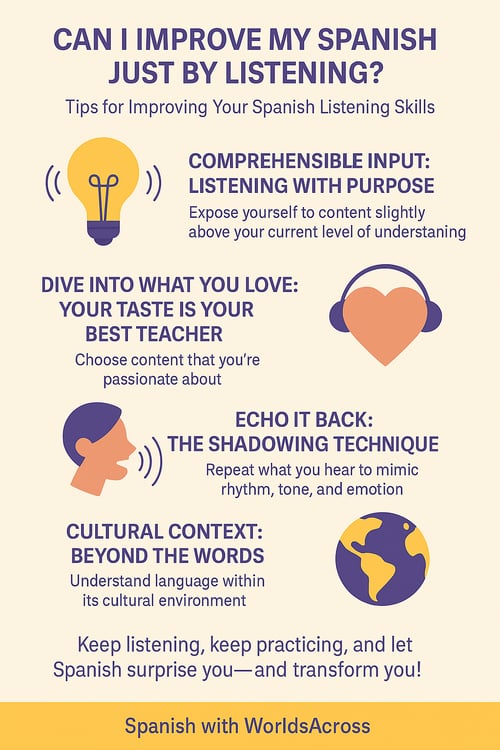Can I Improve My Spanish Just by Listening?
Have you ever found yourself humming a Spanish song without knowing exactly what it says? That melody that sticks in your head, those words you repeat without realizing… That’s the power of listening! But is it enough to master the language? Honestly, it can help you a lot—if you listen with intention. Let’s explore how to improve your Spanish listening skills using methods, tips, and techniques. Ever heard of the comprehensible input method?

Let’s dive into that—and more—below:
Comprehensible Input: Listening with Purpose
The comprehensible input method, proposed by linguist Stephen Krashen, is the key to learning Spanish without stress or boredom. It’s based on exposing yourself to content that’s just one step beyond what you already understand. That way, your brain makes an effort without feeling overwhelmed.
For example, if you already understand phrases like “¿Dónde está el baño?” (“Where is the bathroom?”), you’ll soon be able to catch things like “¿Te importaría decirme dónde queda el baño?” (“Would you mind telling me where the bathroom is?”), without having to study a long vocabulary list.
The most exciting part? This method doesn’t feel like studying. Your ears start picking up on patterns, tones, and pauses… and little by little, without realizing it, you start improving your listening skills. What once sounded like noise starts to sound like a clear, familiar conversation.
Listening actively isn’t just hearing. It’s about opening up to understand, connect, and experience the language.
Dive Into What You Love: Your Taste Is Your Best Teacher
Picture this: you’re watching La Casa de Papel and hear Tokio say with determination, “El corazón de un líder nunca se detiene” (“A leader’s heart never stops”). That line hits you, you love how it sounds, it sticks with you. That’s emotional learning!
When you choose content you’re passionate about—whether it’s a Shakira ballad, a show episode, or a podcast about Latin American food—your brain lights up with natural learning. It’s no longer about memorizing rules, but feeling the language.
For example, if you hear a song that says “Eres mi sol, mi luna, mi todo” (“You are my sun, my moon, my everything”), your brain immediately connects with that universal romanticism. You’re not just learning words—you’re connecting emotionally.
And don’t forget: when you enjoy what you’re listening to, you improve your Spanish listening skills effortlessly. Your motivation grows, and progress becomes inevitable. The content you love is the content you remember.
Echo It Back: The Shadowing Technique
If you’ve ever watched a Spanish movie and tried to pronounce a word you just heard, you’ve already practiced shadowing without knowing it. This technique involves repeating what you hear instantly, mimicking the rhythm, tone, and emotion as closely as possible.
Sounds simple, but it’s incredibly powerful. Practicing shadowing not only boosts your pronunciation, but also trains your ear to detect nuances. Phrases like “No pasa nada” (“It’s okay” / “No big deal”) or “Estoy hecho polvo” (“I’m exhausted”) stop being confusing and start sticking with you like your favorite song.
Each repetition sharpens your ear, strengthens your auditory memory, and yes—improves your listening skills. Imitating isn’t copying; it’s learning with your whole body.
Cultural Context: Beyond the Words
Understanding what someone says doesn’t always mean understanding what they really mean. That’s why improving your listening skills in Spanish also means grasping the world around the words—their gestures, traditions, and emotions. Language lives in context, and in Spanish, each country, city, and even family has its own way of speaking.
Take this Mexican example:
— “¡Qué padre está tu carro!”
No, they’re not talking about your dad. In Mexico, padre means cool or awesome. So what they’re really saying is: “Your car is awesome!”
In Spain, you might hear:
— “Esa fiesta estuvo guay.”
Here, guay is the Peninsular version of padre—both mean cool, but with a different accent and local flavor: “That party was cool.”
Further south, someone might tell you:
— “¡Qué bacán tu acento!”
In Chile and Peru, bacán means great (in Colombia, it’s bacano). In this case, they’re admiring how you speak: “Your accent is awesome.”
See the magic? One idea travels in different outfits depending on the country. That’s why, if you really want to connect with Spanish speakers and not just translate phrases, you need to listen not just with your ears—but with the heart of their cultures.

Your Ears, Your Best Ally for Constant Progress
Improving your Spanish listening skills is a continuous process that requires consistency and regular practice. Every time you expose yourself to authentic content, you take another step toward fluency. Celebrating small wins—like understanding a new phrase or grasping the meaning of a conversation—is key to staying motivated and making steady progress.
Building and enhancing your listening comprehension not only opens the door to new experiences and cultures, but also connects you deeply with native speakers. When you listen actively, dive into what you love, use effective techniques, understand cultural context, and apply the comprehensible input method, Spanish becomes more than just a language—it becomes part of who you are.
Even when the path feels challenging, remember: you’re not alone. With WorldsAcross, we’re here to support you every step of the way, with native Spanish-speaking tutors who’ll offer personalized guidance and help you improve your listening skills day by day.
Keep listening, keep practicing, and let Spanish surprise you—and transform you!


